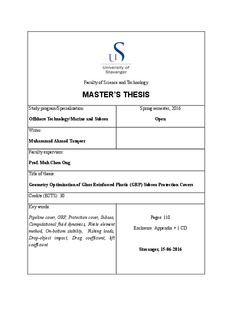| dc.description.abstract | Subsea pipelines are exposed to fishing activity loads and drop-object impacts. Protection covers are used to protect the pipelines from these loads and are manufactured from Glass Reinforced Plastics (GRP) for high strength to weight ratio, manufacturability and low cost. These covers have the primary requirement to protect the pipelines from the loads that they are not designed for, such as loads from the offshore fishing activity and drop-objects. Furthermore, a GRP cover is also exposed to other loading conditions like transportation, installation, lowering through splash zone and on-bottom stability. In all the loading conditions identified, on-bottom stability analysis, fishing activity and drop-object impact loads are the design governing loading conditions. Square, triangular and semi-circular GRP cover geometries are selected for the present study. A sensitivity analysis of the selected GRP cover cross-sections is carried out for the three aforementioned GRP covers under different governing loading conditions.
The current thesis includes a numerical study of square, triangular and semi-circular GRP cover geometries under different loads and a discussion on the geometry optimization, which can assist protection cover designers as an initial design guideline. In order to analyse the GRP cover geometries, hydrodynamic force coefficients are required to compute the forces since hydrodynamic force coefficients data was absent in the open literature. This data is necessary for the present study. Therefore, Computational Fluid Dynamics (CFD) simulations are performed to calculate hydrodynamic force coefficients of the selected geometries. Steady state Reynolds-Averaged Navier-Stokes equations (RANS) with the standard k-ɛ turbulence model under seabed boundary layer flow are used to calculate the hydrodynamic force coefficients. The present study further reveals that the square geometry cover has a drag coefficient of 0.90 and lift coefficient of 0.65, triangular geometry cover has a drag coefficient of 0.80 and lift coefficient of 0.15 and semi-circular geometry cover has a drag coefficient of 0.23 and lift coefficient of 1.40 on average for different boundary layer thicknesses. These drag and lift coefficients are further used for the on-bottom stability analysis of the GRP covers.
The on-bottom stability analysis is carried out using Morrison equations for two different sea states. It concluded that the triangular cover has the highest stability for vertical forces while semi-circular cover has the highest lateral stability.
In fact, fishing activity loads are one of the significant loads for the GRP covers. Finite Element Method (FEM) is used to calculate the load-bearing capacity of the three covers for these loads. Semi-circular geometry cover is determined to be suitable in bearing fishing activity loads as compared to the other two geometry covers.
Similarly, offshore drop-objects are also one of the significant loads for the GRP covers. Drop-object impact analysis is carried out by subjectively selecting offshore drop-objects such as offshore equipment and fishing gear. Impact energies of the selected drop-objects are calculated using energy conservation. The impact absorption capacity of the GRP covers is calculated using FEM. Finally, the calculated impact energies of the drop-objects are compared with the calculated impact absorption capacity of each cover. It is concluded that the semi-circular cover is the most suitable cover among the covers analysed in bearing drop-object impact loads.
The present study inferred that each GRP cover has its own pros and cons. Therefore, it is recommended that the cover geometry should be selected based upon the exposed loading conditions to the cover. | nb_NO |

